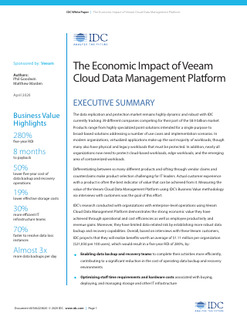The data replication and protection market remains highly dynamic and robust with IDC currently tracking 39 different companies competing for their part of the $8.9 billion market. Products range from highly specialized point solutions intended for a single purpose to broad-based solutions addressing a number of use cases and implementation scenarios. In modern organizations, virtualized applications make up the vast majority of workloads, though many also have physical and legacy workloads that must be protected. In addition, nearly all organizations now need to protect cloud-based workloads, edge workloads, and the emerging area of containerized workloads.
Differentiating between so many different products and sifting through vendor claims and counterclaims make product selection challenging for IT leaders. Actual customer experience with a product is often the best indicator of value that can be achieved from it. Measuring the value of the Veeam Cloud Data Management Platform using IDC’s Business Value methodology via interviews with customers was the goal of this effort.
IDC’s research conducted with organizations with enterprise-level operations using Veeam Cloud Data Management Platform demonstrates the strong economic value they have achieved through operational and cost efficiencies as well as employee productivity and revenue gains. Moreover, they have limited data-related risk by establishing more robust data backup and recovery capabilities. Overall, based on interviews with these Veeam customers, IDC projects that they will realize benefits worth an average of $1.11 million per organization ($21,050 per 100 users), which would result in a five-year ROI of 280%, by:
• Enabling data backup and recovery teams to complete their activities more efficiently, contributing to a significant reduction in the cost of operating data backup and recovery environments
• Optimizing staff time requirements and hardware costs associated with buying, deploying, and managing storage and other IT infrastructure
• Improving business outcomes through greater confidence in data, lower risk, and more impactful development efforts
• Establishing more robust and functional data backup and recovery environments, which reduces operational and business risk related to handling and using data

